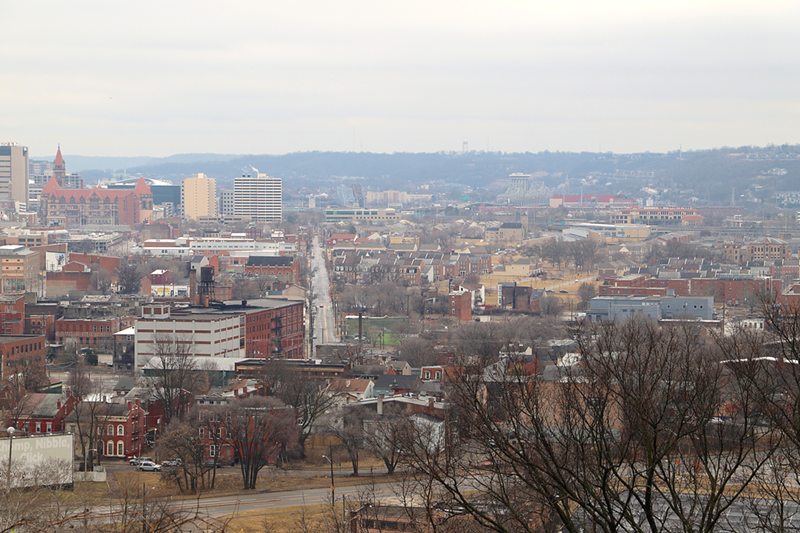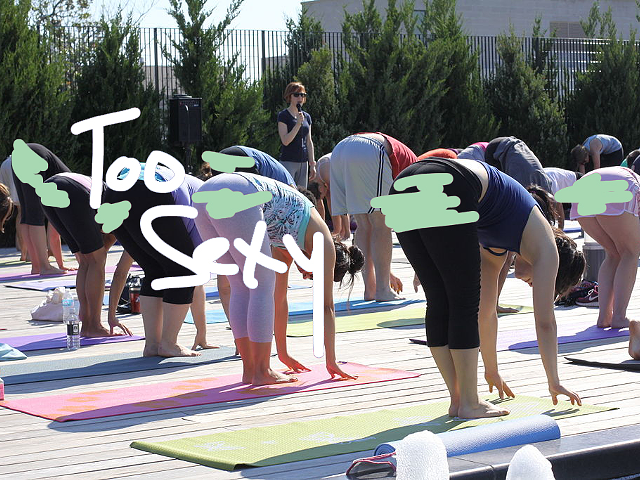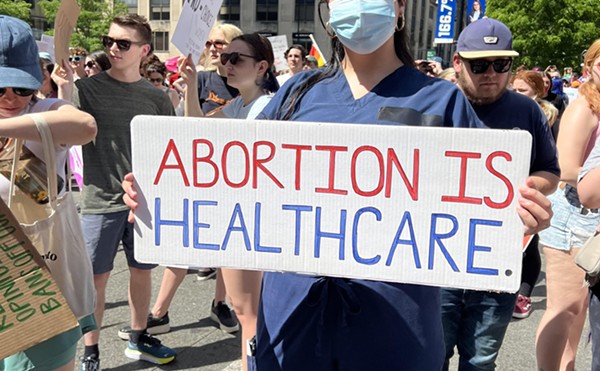Rachel Anderson was born on Hopkins Street in the West End 78 years ago, and moved out of the neighborhood when the entire southern half of the neighborhood, called Kenyon-Barr by city planners, was razed in the early 1960s to make way for I-75 and as part of federal “slum clearance” programs. Some 25,000-30,000 residents, mostly black Cincinnatians who hadn't been permitted to live many other places in town, were displaced by that effort. The area, now called Queensgate, is mostly industrial land, some of it vacant.
Anderson was finally able to make her way back to the West End in 2010, and now lives in senior housing on Linn Street a few blocks from where FC Cincinnati plans to construct a 21,000 seat, privately-funded $250 million stadium, as well as a replacement stadium for Taft High School across the street.
Anderson isn't happy about the plan.
"They want to put it right in the midst of where people are living," Anderson says. She's concerned about the noise, traffic and other disruptions she could experience from the soccer stadium and the new Stargel Stadium, which will be very close to her. Anderson wants to know why the Lindners, who own United Dairy Farmers and whose Carl Lindner III is a part owner of FC Cincinnati, won't put a UDF in the West End.The neighborhood doesn't have a grocery store or bakery, she points out, and needs those things first.
She's also worried about being displaced again.
"This is going to bring a lot of pain for me," she says.
While it’s hard to say whether FCC's stadium could cause displacement of the neighborhood’s residents, we can look beyond the myths about the West End — that it’s mostly vacant, or that it’s almost all housing owned by Cincinnati’s housing authority — to understand a little bit more about what’s at stake, who may be vulnerable and why at least some residents are worried about the idea of a large stadium near their homes.
Recent moves by FC Cincinnati have shined a new spotlight on the neighborhood, a historically African-American community just west of downtown and Over-the-Rhine.
On Feb. 12, FCC told the Cincinnati Public Schools Board of Education that, should it win a franchise from Major League Soccer, it would like to consider building its new soccer stadium on the site of Stargel Stadium next to Taft High School. In exchange, it would build a new stadium for CPS students south of Ezzard Charles Drive on the site once slated for higher-end housing as part of CitiRama.
The idea isn't a done deal. FCC is also still considering Newport and Oakley, team officials say. But if it were to happen, FCC leadership says the move would bring development to the low-income neighborhood.
Opponents of the potential plan, however, say it could spark real estate speculation in the West End and lead to the displacement of residents there.
“I can assure you that there will be displacement of residents as other people begin to speculate about what they can do in the community,” said Cincinnati City Councilman Wendell Young after FCC’s presentation to the CPS board last week. “We've seen this before, the West End in particular, always in the name of progress."
Others, however, say that wouldn’t happen.
Long home to a large portion of Cincinnati’s black population, the West End has seen decades of disinvestment as well as some very disruptive large-scale demolition. It's home to a sizeable low-income population, large amounts of both subsidized and non-subsidized affordable housing, historic architecture and local African American cultural landmarks, all in various states of vulnerability or protection.
Even without the destruction of housing, a multi-million-dollar stadium in the West End could trigger rent increases, property tax spikes and land speculation that could cost some renters — who make up 84 percent of the West End's residents — their homes.
The neighborhood contains roughly 1,000 units of rental housing locked into long-term affordability due to ownership by Cincinnati Metropolitan Housing Authority or because they were built by private developers like The Community Builders using Low Income Housing Tax Credits.
Census data shows that more than 3,000 of the neighborhood's residents live below the poverty line. Another 1,300 live above poverty level but still well below the income needed to comfortably afford the city's median rent, which has hovered around $900 a month in recent months.
The gap has made some in the neighborhood very nervous about big changes coming.
“The West End's history is rich with devastation,” resident Tia Brown told the Cincinnati Public Schools Board of Education earlier this month during a meeting about FCC’s plans. “We know that development is needed, but we want it to be equitable with the community at the table.”
Others — residents and outsiders — have echoed similar views in public forums around the stadium plans.
A few dozen residents came to a public input session held by Seven Hills Neighborhood Houses and the West End Community Council on Feb. 15.
FCC General Manager Jeff Berding and former mayor Mark Mallory spoke first, promising the neighborhood would receive a community benefits agreement, highlighting the economic development that could come to the neighborhood and asking what residents wanted out of a potential stadium deal.
The team has retained former mayor Mallory to do community development work in the West End as well as Newport and Oakley, the stadium's other potential sites. Mallory, one member of a prominent West End family, also spoke to the neighborhood's community council Feb. 13.
His brother Joe Mallory, vice president of Cincinnati's NAACP branch, opposes the stadium in the neighborhood.
"The bottom line is, if FC Cincinnati hears a majority of residents saying they don't want a stadium here, it won't be here," former mayor Mallory said, to applause from some in audience. He continued: "Gone with it will be an opportunity to reinvest in the West End."
At the community council meeting, Berding and former Mayor Mallory were peppered by questions and deep concern from residents. Again and again, themes arose: the stadium would bring rising prices, property speculation and displacement.
"Everything is showing us that's what's going to happen," says resident Tabitha Dornal of potential changes to the neighborhood. "The new restaurants and bars on Vine Street (in neighboring Over-the-Rhine) — we go to those places, we can kind of afford them sometimes, but none of this stuff is going to help us. We'd love to have our neighborhood fixed up, but why can't it happen for us? Why does it need to be fixed up because of a stadium?"
Dornal says she's not dead set against the stadium in and of itself.
"I really would like it, in certain aspects," she says. "I would like it to fit what this neighborhood is, though. We like basketball, football, track. But we probably would be more receptive if they had come in our community centers earlier teaching us about soccer. There should have been a better way to sell it to the community."
For residents like Dornal, the potential big changes call up unpleasant memories.
The lots where FCC proposes it will build the new Stargel Stadium, and land north of that where it has gained a purchase option from the Cincinnati Metropolitan Housing Authority, once held Laurel Homes and Lincoln Courts. Those projects were demolished as part of the federal government’s Hope VI program in the early 2000s. That has left sour memories in the neighborhood, some say, even though the program resulted in the construction of the mixed-income developments called City West.
Laurel Homes and neighboring Lincoln Courts, constructed in the 1930s, were once home to 5,000 low-income people in 2,000 housing units. They were down to roughly 1,100 units of old, deteriorated housing when they were demolished during the Hope VI program.
Initially, 250 owner-occupied town homes, 338 market-rate apartments and 434 subsidized apartments were supposed to be built as part of that project. But the project suffered delays and accusations of mismanagement.
Eventually, 686 new units of mixed-income housing were created in place of Laurel Homes and Lincoln Court. Some residents who were promised housing in the neighborhood were never able to come back, groups like the Cincinnati NAACP say.
Dornal lives in City West, just west of Stargel. She remembers being moved from Lincoln Courts when it was torn down last decade. She says her mother, who now lives on the other side of the neighborhood in Richmond Village, was told she would be able to move into City West, but was not able to.
The Cincinnati Metropolitan Housing Authority says it doesn't have any records of complaints by people who were removed from Lincoln Courts and weren't given housing in City West, but residents like Dornal dispute that.
Now, they're struggling with different problems.
"No one is accepting the Section 8 vouchers," she says. "That's why people want to stay where they're at."
According to Dornal, the number of landlords who take the housing subsidies has dwindled. Over the last few decades, HUD and housing authorities began switching to the vouchers over government-owned housing projects like Laurel Homes and Lincoln Courts. That could accelerate in the coming years as CMHA looks for new ways to manage its costs through programs like Rental Assistance Demonstration, which effectively privatizes some public housing funding, and as federal housing policies move further away from public housing projects.
According to the 2016 American Community Survey, roughly 6,140 people live in the West End — more than live in Over-the-Rhine. That’s counting the neighborhood’s three complete Census tracts and Census tract 265’s block group one, which accounts for a small southern corner of the neighborhood containing around 800 people. The second, larger block group of that tract accounts for a big swath of wealthier, whiter areas in downtown.
While the ACS data is just an estimate, it matches up well with more rigorous 2010 Census results.
African-Americans make up about 86 percent of West End residents. The median household income for the neighborhood is roughly $15,000 a year — well less than half the city's overall median.
Overall, the neighborhood has a vacancy rate of around 22 percent. There are empty buildings here, but many housing units are occupied.
Using CAGIS, Hamilton County’s online mapping tool, it's possible to explore each part of the neighborhood directly around the stadium to see who owns what and where people live.
About 2,400 people live in Census Tract 264, where the stadium would be located. That tract is bounded by Linn Street to the west, Central Parkway to the east, Liberty Street to the north and Court Street to the south.
Some live in about two dozen buildings containing affordable housing owned by the Cincinnati Metropolitan Housing Authority west of Stargel. The Community Builders, a Boston-based developer, own about another 250 below-market rate rental units in the area called City West that currently have rent restrictions due to the fact they've received Low Income Housing Tax Credits from the Department of Housing and Urban Development.
That represents most of the units in the neighborhood that have rent restrictions, save a few units on Mound Street in the southern part of the neighborhood and a tower on Ninth Street on the border with downtown.
There are also about three dozen privately owned residential multi-family properties in the area along Laurel Park, Laurel Park East, Laurel Park West and Ezzard Charles Drive.
South of where FCC would build the new Stargel Stadium is the Betts-Longworth historic district, a few blocks of historic single-family and small multi-family buildings, some of the oldest still standing in the city. A few more nearby blocks contain more recently constructed rowhouse-style buildings.
Census tract 269 is directly to the north of the stadium’s proposed site. This tract, with a population of roughly 1,900 people, contains another series of large CMHA developments — roughly 500 units of affordable housing at Stanley Rowe Towers and nearby townhouses.
The southern part of that tract along Liberty Street is mostly zoned manufacturing. Further north, it contains dozens of privately owned multi-family rental buildings along Poplar, Livingston and other streets, as well as historic single family homes in the Dayton Street historic district.
The area also has a rather unique attribute — a small urban land trust created by churches in the neighborhood in 1981 to prevent displacement of some of the neighborhood’s low-income black residents. Many sources say it was the first such urban land trust in the country, though others have since sprung up in some other cities.
The neighborhood’s final full Census tract, tract 2, has a population of just more than 1,000 people and is dominated by several large apartment complexes. One, Parktown Community Homes, is a cooperatively owned 370 unit housing development constructed in 1961 as an early attempt at integrated housing. Some of its residents have lived in the development since it was built. To the south of Ezzard Charles Drive are apartments like Richmond Village, a 252-unit senior apartment complex where West End resident Dornal's mother lives. These apartment buildings are privately owned, but offer affordable housing via a HUD Housing Assistance Program contract set to expire 2020.
FCC officials have said that the stadium won't add to the neighborhood's woes, instead offering positive contributions. Berding said he spent 10 hours in the West End on the weekend of Feb. 10, and touted a community survey that spoke to more than 160 West End residents about their concerns and wants from the prospect of the stadium.
The team has lauded the construction of a soccer stadium in Orlando's Parramore neighborhood, a similarly low-income, historically African American community. Some residents there are hopeful that the 20,000-30,000 soccer fans will bring better economic prospects to the neglected community, and even a church that refused to sell its land to make way for the stadium admits there are some benefits to the team being next door, though they say there have been negatives, too. But the jury is still out on the impact the stadium has had, and some experts say to temper expectations.
“That sounds like a lot of economic activity, but it’s a tiny drop in a very large pond in terms of the economy,” Florida State University economist Tim Chapin told the Orlando Sentinel about the stadium there. “There will be a few winners in this, but it’s not a rising tide that lifts all boats.”
What would a similar stadium in the West End mean for residents there? It's complex, urban planning experts say.
"It depends on a lot of factors," says University of Cincinnati Urban Planning professor David Varady. "Downtown arenas can spur downtown revitalization, which I think is a good thing. I think two historically significant ball parks, Wrigley Field and Fenway Park, have benefited nearby areas in Chicago and Boston. On the other hand, Yankee Stadium has generally not benefited surrounding areas of the South Bronx."
Varady says the city could play a role in whether the stadium is a positive or negative in the West End.
"The city could ensure that the soccer team signs a community benefit agreement which would ensure that construction firms employ minority/local residents," he says. Such a benefits agreement has been suggested by Cincinnati City Councilman David Mann, and FCC has agreed to sign it. "Such agreements have been worked out in other cities. Parking would be a major issue — and the city and other levels of government should increase the public transit options. The latter existed for Crosley Field and also currently exist for Camden Yards (in Baltimore)."
Varady also says the team should conduct outreach in the neighborhood to "involve youngsters in what is mostly a suburban-oriented sport in the U.S."
Cincinnati has considered the impact of stadiums before when it was mulling the economic impact of Paul Brown Stadium. A study done by the city that year, which included economic research from University of Cincinnati and consultants ZHA, Inc., found that even that massive project would probably have had little positive economic impact.
"Stadiums rarely generate sufficient patronage and expenditures to independently leverage new development or other significant economic activity in the surrounding area," the study reads, citing ZHA's research.
As debate over the stadium rages, West End Community Council president Keith Blake says that elected officials and outside groups should let the West End make its own decision.
"We still have a lot of people who are not residents in the community trying to speak on the community's behalf," Blake says. "That's a dangerous, dangerous thing. The community council, the voice of the community, hasn't said yes or no. We need to let the residents of the community decide what happens. It's not a done deal."
Blake says he's working to arrange private meetings between residents at Stanley Rowe Towers, Parktown and other complexes and the team. He admits he's open to the possibility of an FCC stadium in the West End.
"But I have one vote," he says.






